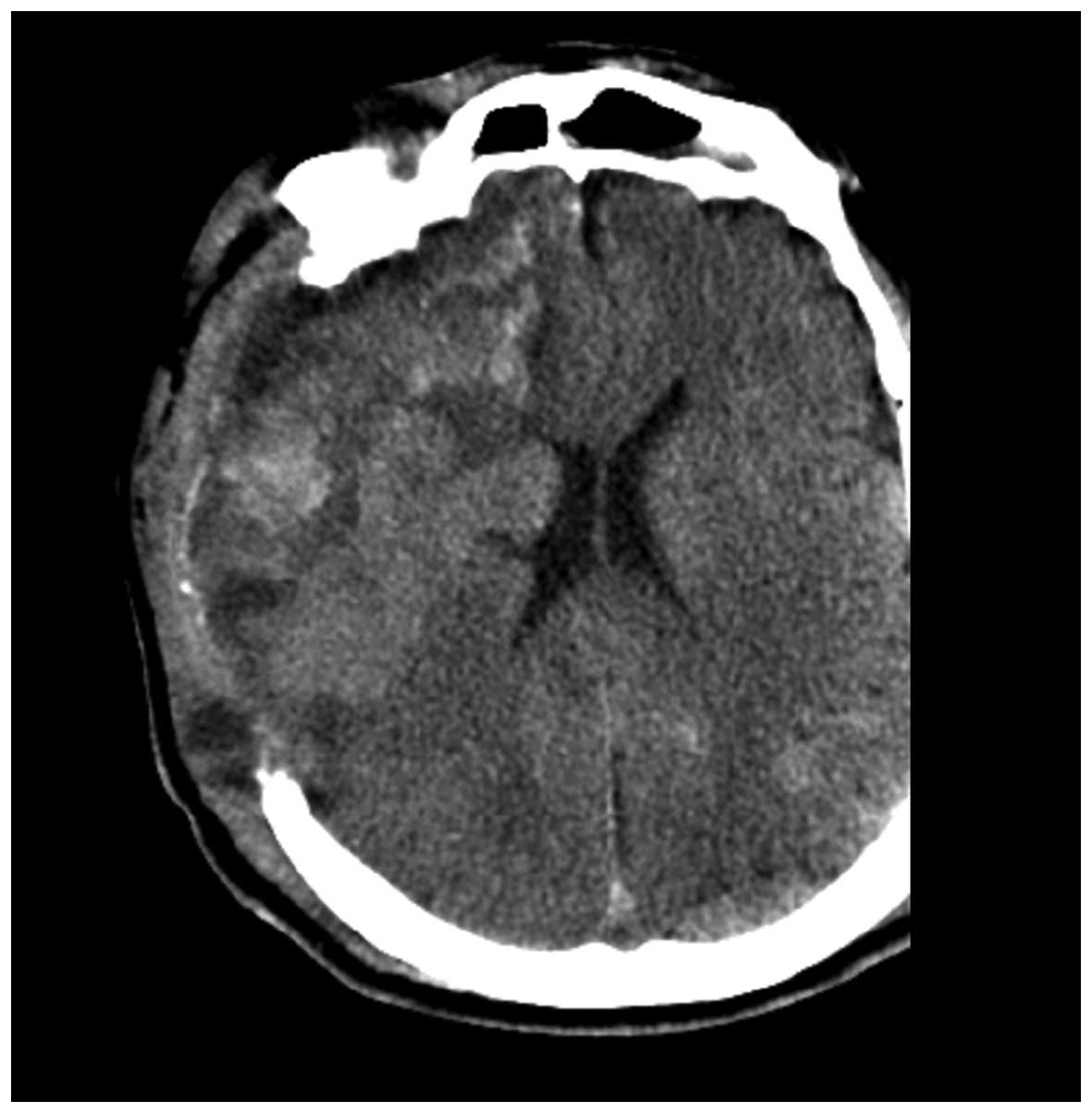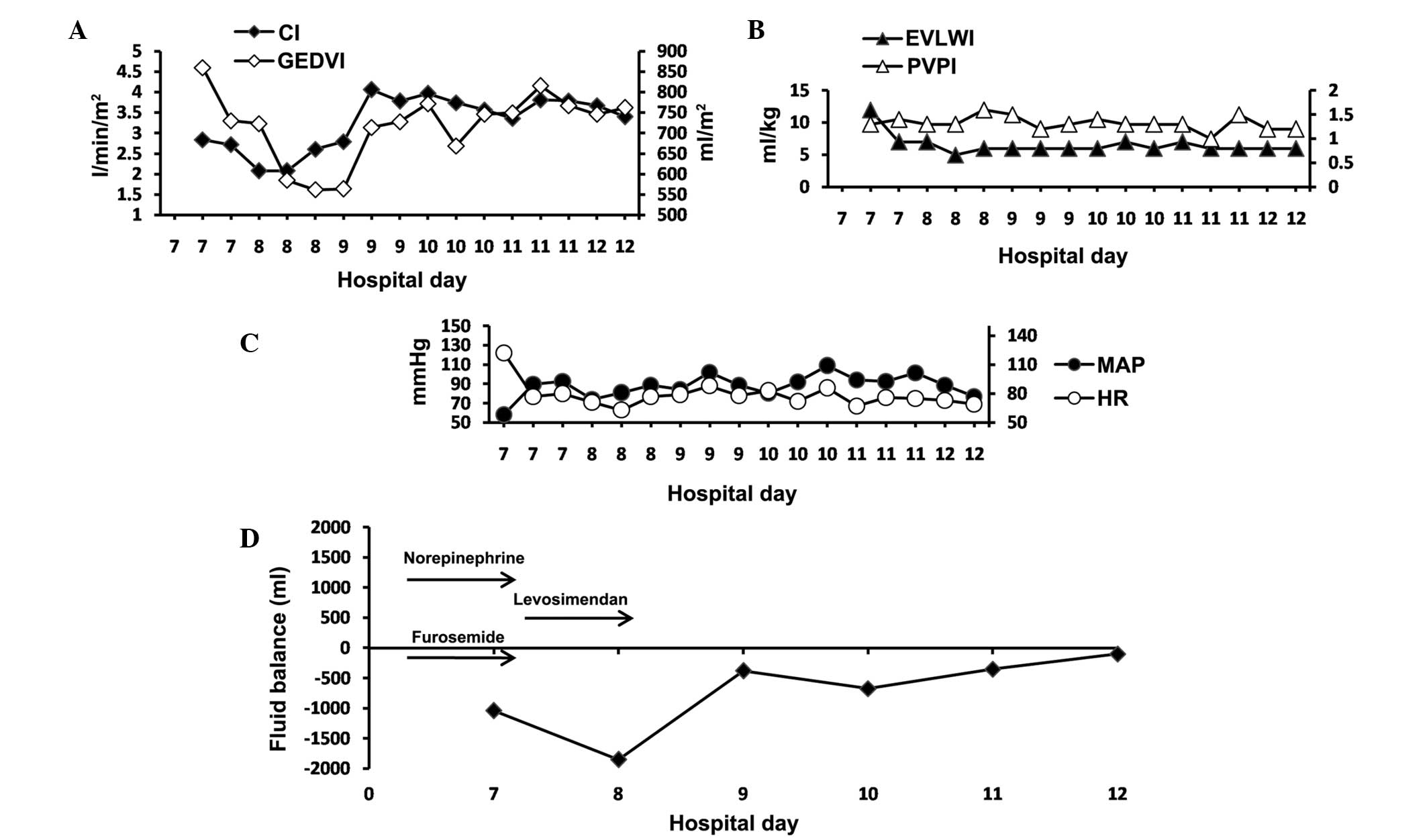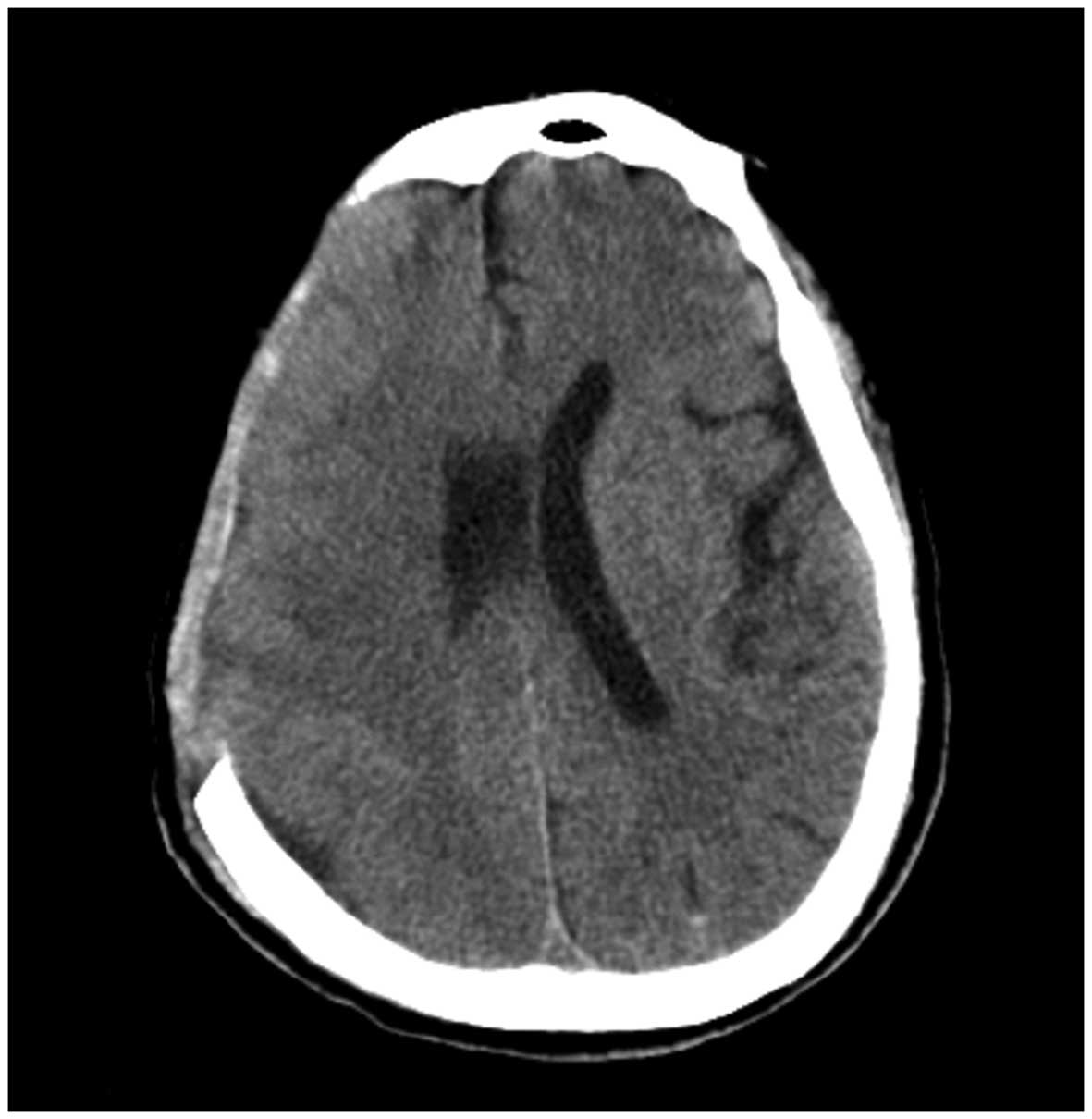|
1
|
Davison DL, Terek M and Chawla LS:
Neurogenic pulmonary edema. Crit Care. 16:2122012. View Article : Google Scholar : PubMed/NCBI
|
|
2
|
Langlois JA, Rutland-Brown W and Wald MM:
The epidemiology and impact of traumatic brain injury: A brief
overview. J Head Trauma Rehabil. 21:375–378. 2006. View Article : Google Scholar : PubMed/NCBI
|
|
3
|
Bratton SL and Davis RL: Acute lung injury
in isolated traumatic brain injury. Neurosurgery. 40:707–712;
discussion 712. 1997. View Article : Google Scholar : PubMed/NCBI
|
|
4
|
Rogers FB, Shackford SR, Trevisani GT,
Davis JW, Mackersie RC and Hoyt DB: Neurogenic pulmonary edema in
fatal and nonfatal head injuries. J Trauma. 39:860–866; discussion
866–868. 1995. View Article : Google Scholar : PubMed/NCBI
|
|
5
|
Sedy J, Zicha J, Kunes J, Jendelova P and
Syková E: Mechanisms of neurogenic pulmonary edema development.
Physiol Res. 57:499–506. 2008.PubMed/NCBI
|
|
6
|
Mutoh T, Kazumata K, Kobayashi S, Terasaka
S and Ishikawa T: Serial measurement of extravascular lung water
and blood volume during the course of neurogenic pulmonary edema
after subarachnoid hemorrhage: Initial experience with 3 cases. J
Neurosurg Anesthesiol. 24:203–208. 2012. View Article : Google Scholar : PubMed/NCBI
|
|
7
|
Friesecke S, Heinrich A, Abel P and Felix
SB: Comparison of pulmonary artery and aortic transpulmonary
thermodilution for monitoring of cardiac output in patients with
severe heart failure: Validation of a novel method. Crit Care Med.
37:119–123. 2009. View Article : Google Scholar : PubMed/NCBI
|
|
8
|
Davison DL, Chawla LS, Selassie L, Tevar
R, Junker C and Seneff MG: Neurogenic pulmonary edema: Successful
treatment with IV phentolamine. Chest. 141:793–795. 2012.
View Article : Google Scholar : PubMed/NCBI
|
|
9
|
McMurray JJ, Adamopoulos S, Anker SD,
Auricchio A, Böhm M, Dickstein K, Falk V, Filippatos G, Fonseca C,
Gomez-Sanchez MA, et al: ESC guidelines for the diagnosis and
treatment of acute and chronic heart failure 2012: The Task Force
for the Diagnosis and Treatment of Acute and Chronic Heart Failure
2012 of the European Society of Cardiology Developed in
collaboration with the Heart Failure Association (HFA) of the ESC.
Eur J Heart Fail. 14:803–869. 2012. View Article : Google Scholar : PubMed/NCBI
|
|
10
|
Rieg AD, Rossaint R, Verjans E, Maihöfer
NA, Uhlig S and Martin C: Levosimendan Relaxes Pulmonary Arteries
and Veins in Precision-Cut Lung Slices-The Role of KATP -Channels,
cAMP and cGMP. PLoS One. 8:e661952013. View Article : Google Scholar : PubMed/NCBI
|
|
11
|
Teasdale G and Jennett B: Assessment of
coma and impaired consciousness. A practical scale. Lancet.
2:81–84. 1974. View Article : Google Scholar : PubMed/NCBI
|
|
12
|
Werner C and Engelhard K: Pathophysiology
of traumatic brain injury. Br J Anaesth. 99:4–9. 2007. View Article : Google Scholar : PubMed/NCBI
|
|
13
|
Brashear RE and Ross JC: Hemodynamic
effects of elevated cerebrospinal fluid pressure: Alterations with
adrenergic blockade. J Clin Invest. 49:1324–1333. 1970. View Article : Google Scholar : PubMed/NCBI
|
|
14
|
Nathan MA and Reis DJ: Fulminating
arterial hypertension with pulmonary edema from release of
adrenomedullary catecholamines after lesions of the anterior
hypothalamus in the rat. Circ Res. 37:226–235. 1975. View Article : Google Scholar : PubMed/NCBI
|
|
15
|
Gekka M, Yamaguchi S, Kazumata K,
Kobayashi H, Motegi H, Terasaka S and Houkin K: Hemorrhagic onset
of hemangioblastoma located in the dorsal medulla oblongata
presenting with tako-tsubo cardiomyopathy and neurogenic pulmonary
edema: A case report. Case Rep Neurol. 6:68–73. 2014. View Article : Google Scholar : PubMed/NCBI
|
|
16
|
Manto A, De Gennaro A, Manzo G, Serino A,
Quaranta G and Cancella C: Early endovascular treatment of
aneurysmal subarachnoid hemorrhage complicated by neurogenic
pulmonary edema and Takotsubo-like cardiomyopathy. Neuroradiol J.
27:356–360. 2014. View Article : Google Scholar : PubMed/NCBI
|
|
17
|
Inamasu J, Nakatsukasa M, Mayanagi K,
Miyatake S, Sugimoto K, Hayashi T, Kato Y and Hirose Y:
Subarachnoid hemorrhage complicated with neurogenic pulmonary edema
and takotsubo-like cardiomyopathy. Neurol Med Chir (Tokyo).
52:49–55. 2012. View Article : Google Scholar : PubMed/NCBI
|
|
18
|
Merenkov VV, Kovalev AN and Gorbunov VV:
Bedside lung ultrasound: A case of neurogenic pulmonary edema.
Neurocrit Care. 18:391–394. 2013. View Article : Google Scholar : PubMed/NCBI
|
|
19
|
Patroniti N, Bellani G, Maggioni E, Manfio
A, Marcora B and Pesenti A: Measurement of pulmonary edema in
patients with acute respiratory distress syndrome. Crit Care Med.
33:2547–2554. 2005. View Article : Google Scholar : PubMed/NCBI
|
|
20
|
Berkowitz DM, Danai PA, Eaton S, Moss M
and Martin GS: Accurate characterization of extravascular lung
water in acute respiratory distress syndrome. Crit Care Med.
36:1803–1809. 2008. View Article : Google Scholar : PubMed/NCBI
|
|
21
|
Craig TR, Duffy MJ, Shyamsundar M,
McDowell C, McLaughlin B, Elborn JS and McAuley DF: Extravascular
lung water indexed to predicted body weight is a novel predictor of
intensive care unit mortality in patients with acute lung injury.
Crit Care Med. 38:114–120. 2010. View Article : Google Scholar : PubMed/NCBI
|
|
22
|
Gupta YK, Chugh A, Kacker V, Mehta VS and
Tandon PN: Development of neurogenic pulmonary edema at different
grades of intracranial pressure in cats. Indian J Physiol
Pharmacol. 42:71–80. 1998.PubMed/NCBI
|
|
23
|
Goedje O, Hoeke K, Lichtwarck-Aschoff M,
Faltchauser A, Lamm P and Reichart B: Continuous cardiac output by
femoral arterial thermodilution calibrated pulse contour analysis:
Comparison with pulmonary arterial thermodilution. Crit Care Med.
27:2407–2412. 1999. View Article : Google Scholar : PubMed/NCBI
|
|
24
|
Rocca G Della, Costa MG, Coccia C, Pompei
L, DiMarco P, Vilardi V and Pietropaoli P: Cardiac output
monitoring: Aortic transpulmonary thermodilution and pulse contour
analysis agree with standard thermodilution methods in patients
undergoing lung transplantation. Can J Anaesth. 50:707–711. 2003.
View Article : Google Scholar : PubMed/NCBI
|
|
25
|
Bahloul M, Chaari AN, Kallel H, Khabir A,
Ayadi A, Charfeddine H, Hergafi L, Chaari AD, Chelly HE, Ben Hamida
C, et al: Neurogenic pulmonary edema due to traumatic brain injury:
Evidence of cardiac dysfunction. Am J Crit Care. 15:462–470.
2006.PubMed/NCBI
|
|
26
|
Mees SM Dorhout, Hoff RG, Rinkel GJ, Algra
A and van den Bergh WM: Brain natriuretic peptide concentrations
after aneurysmal subarachnoid hemorrhage: Relationship with
hypovolemia and hyponatremia. Neurocrit Care. 14:176–181. 2011.
View Article : Google Scholar : PubMed/NCBI
|
|
27
|
Sviri GE, Soustiel JF and Zaaroor M:
Alteration in brain natriuretic peptide (BNP) plasma concentration
following severe traumatic brain injury. Acta Neurochir (Wien).
148:529–533; discussion 533. 2006. View Article : Google Scholar : PubMed/NCBI
|
|
28
|
Fontes RB, Aguiar PH, Zanetti MV, Andrade
F, Mandel M and Teixeira MJ: Acute neurogenic pulmonary edema: Case
reports and literature review. J Neurosurg Anesthesiol. 15:144–150.
2003. View Article : Google Scholar : PubMed/NCBI
|
|
29
|
Baumann A, Audibert G, McDonnell J and
Mertes PM: Neurogenic pulmonary edema. Acta Anaesthesiol Scand.
51:447–455. 2007. View Article : Google Scholar : PubMed/NCBI
|
|
30
|
Busl KM and Bleck TP: Neurogenic Pulmonary
Edema. Crit Care Med. 43:1710–1715. 2015. View Article : Google Scholar : PubMed/NCBI
|
|
31
|
Videtta W, Villarejo F, Cohen M,
Domeniconi G, Cruz R Santa, Pinillos O, Rios F and Maskin B:
Effects of positive end-expiratory pressure on intracranial
pressure and cerebral perfusion pressure. Acta Neurochir Suppl.
81:93–97. 2002.PubMed/NCBI
|
|
32
|
Matsuyama T, Okuchi K, Nishiguchi T, Seki
T and Murao Y: Neurogenic pulmonary edema caused by a medulla
oblongata lesion after head trauma. J Trauma. 63:700–702. 2007.
View Article : Google Scholar : PubMed/NCBI
|
|
33
|
Kersten JR, Montgomery MW, Pagel PS and
Warltier DC: Levosimendan, a new positive inotropic drug, decreases
myocardial infarct size via activation of K (ATP) channels. Anesth
Analg. 90:5–11. 2000. View Article : Google Scholar : PubMed/NCBI
|
|
34
|
Huang X, Lei S, Zhu MF, Jiang RL, Huang
LQ, Xia GL and Zhi YH: Levosimendan versus dobutamine in critically
ill patients: A meta-analysis of randomized controlled trials. J
Zhejiang Univ Sci B. 14:400–415. 2013. View Article : Google Scholar : PubMed/NCBI
|
|
35
|
Delaney A, Bradford C, McCaffrey J,
Bagshaw SM and Lee R: Levosimendan for the treatment of acute
severe heart failure: A meta-analysis of randomised controlled
trials. Int J Cardiol. 138:281–289. 2010. View Article : Google Scholar : PubMed/NCBI
|
|
36
|
Landoni G, Biondi-Zoccai G, Greco M, Greco
T, Bignami E, Morelli A, Guarracino F and Zangrillo A: Effects of
levosimendan on mortality and hospitalization. A meta-analysis of
randomized controlled studies. Crit Care Med. 40:634–646. 2012.
View Article : Google Scholar : PubMed/NCBI
|
|
37
|
Oner E, Erturk M, Birant A, Mansıroglu A
Kurtar, Akturk IF, Karakurt H, Yalcin AA, Uzun F, Somuncu MU and
Yildirim A: Assessment of sustained effects of levosimendan and
dobutamine on left ventricular systolic functions by using novel
tissue Doppler derived indices in patients with advanced heart
failure. Cardiol J. 22:87–93. 2014. View Article : Google Scholar : PubMed/NCBI
|
|
38
|
Roehl AB, Hein M, Loetscher PD, Rossaint
J, Weis J, Rossaint R and Coburn M: Neuroprotective properties of
levosimendan in an in vitro model of traumatic brain injury. BMC
Neurol. 10:972010. View Article : Google Scholar : PubMed/NCBI
|
|
39
|
Hein M, Zoremba N, Bleilevens C, Bruells
C, Rossaint R and Roehl AB: Levosimendan limits reperfusion injury
in a rat middle cerebral artery occlusion (MCAO) model. BMC Neurol.
13:1062013. View Article : Google Scholar : PubMed/NCBI
|
|
40
|
Lafci B, Yasa H, Ilhan G, Ortac R, Yilik
L, Kestelli M, Goktogan T and Gurbuz A: Protection of the spinal
cord from ischemia: Comparative effects of levosimendan and
iloprost. Eur Surg Res. 41:1–7. 2008. View Article : Google Scholar : PubMed/NCBI
|
|
41
|
Das B and Sarkar C: Pharmacological
preconditioning by levosimendan is mediated by inducible nitric
oxide synthase and mitochondrial KATP channel activation in the in
vivo anesthetized rabbit heart model. Vascul Pharmacol. 47:248–256.
2007. View Article : Google Scholar : PubMed/NCBI
|
|
42
|
Hönisch A, Theuring N, Ebner B, Wagner C,
Strasser RH and Weinbrenner C: Postconditioning with levosimendan
reduces the infarct size involving the PI3K pathway and
KATP-channel activation but is independent of PDE-III inhibition.
Basic Res Cardiol. 105:155–167. 2010. View Article : Google Scholar : PubMed/NCBI
|



















